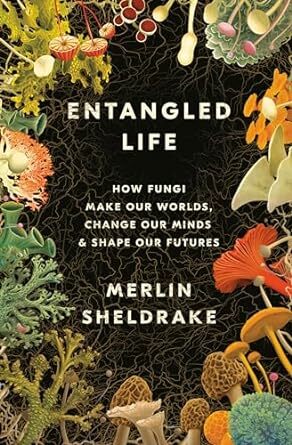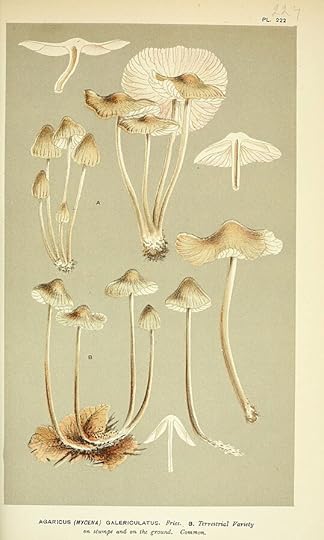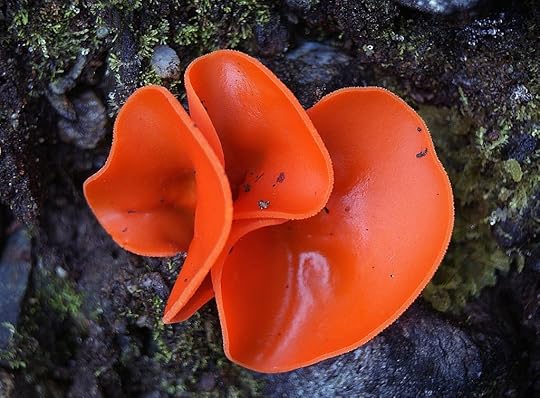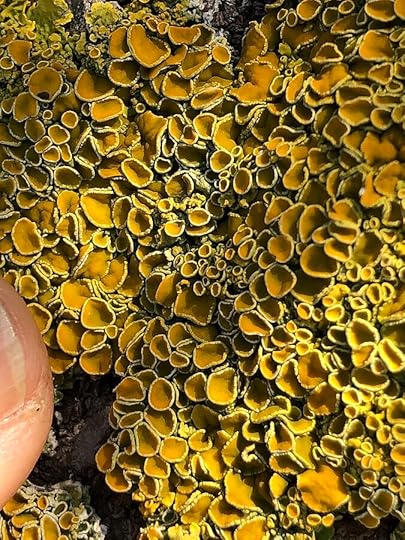ENTANGLED LIFE
How Fungi Make Our Worlds, Change Our Minds, & Shape Our Futures

By Merlin Sheldrake
First off, did you know fungi is a kingdom of life— like a totally different category from animals and plants. Generally, fungi have been relegated to study under plants, and we know relatively little about this curious kingdom. One estimate is that only 6% of fungi species have even been described by science at this point. Yet without fungi, plants may not have developed root systems to evolve out of water. Additionally, fungi are the first organisms to break down bare rock to produce fertile soil. With diverse metabolisms, fungi can dissolve wood, rock, crude oil, plastic, and TNT. Some can clean up nuclear waste.
Most people don’t realize the extent to which we depend on fungi in our lives. Because fungi are more closely related to animals than plants, we use some fungal solutions to solve human health problems. Penicillin, cyclosporine, statins, many anti-cancer, and anti-viral drugs rely on fungi. Then there’s alcohol and magic mushrooms (psilocybin).

Humans depend on plant life and as it turns out, fungi supply plants with nutrients from the soil. In exchange, fungi get sugars and lipids generated from photosynthesis. This ancient relationship developed and continues to sustain life and us to this day. More than ninety percent of plant species rely on mycorrhizal fungi. This little understood ecosystem of fungal networks with plants became the life work of the author.
Sheldrake’s work (along with others) in this field have prompted new ways of thinking about the world. Fungi appear capable of very sophisticated behaviors pushing the need for new models to explain how these organisms communicate, solve problems, make decisions, learn, and remember.

Into the weird world of fungi:
Worm-hunting fungus: Generally, are happy eating decomposing plant material but when there is a shortage of food, they develop worm-hunting organs & produce chemical signals to lure nematodes.
Maze runners: Experiments with mycelium have shown they can work out the best routes between British cities creating a recognizable motorway (Lynne Boddy, PhD).
Burst asphalt: Some mushrooms take on water and are capable of pushing through asphalt.
Communication across the fungal network: The current theory suggests electrical signaling may convey information about food, injury, outsiders, or local conditions.
Fungal computers: Growing a mycelium ecosystem (in the future) may allow large-scale environmental monitoring.
What’s a lichen? A source of confusion. Where does one organism stop and another start? The more we know about lichens, the harder they are to define or classify. An open-ended question in science at this point.
Zombie fungus: One fungus which infects carpenter ants removes their fear of heights. The ant climbs a plant, clamps its jaw in a death grip, then mycelium grow from its feet binding it to the plant. After digesting the ant’s body, a stalk grows from the head dispersing spores. Called “zombie” because the fungus controls the brains of the ants in ways scientists can’t explain. The death grip is executed precisely in the right temperature and humidity zone to allow the fungus to fruit. Infected ants all bite together at noon, facing the sun and clamping a major plant vein.
Laughing mushrooms: In 1486, at the coronation of an Aztec emperor laughing broke out after consumption of the mushroom known as “flesh of the gods,” one kind of psilocybin mushroom.
Fungus partners affect produce: Tests with strawberries grown with different fungal communities changed the flavor of the berries. What does this mean for gardeners/farmers going forward?
Wood Wide Web: The vast connection of plants and fungus to transport everything from nutrients to signaling compounds. Poisons and hormones can pass through shared networks. Genetic material (viruses, RNA) may also be passing through fungal channels.
Bee Colony Collapse: Promising research is under way to see if white rot fungi can be used to reduce bee mortality.

I hope this dive into the strange world of fungus has whetted your appetite for more. There is a lot in this book. The author outlines some of the groundbreaking areas of research and production that are ongoing. Some of it feels like science fiction. He acknowledges the contributions of citizen mycologists who have pushed the field (and continue to do so). The kingdom of fungi may well hold solutions for humanity as we discover more and open our awareness to these lifeforms.
TO FIND MY BOOKS:
BOOKS



